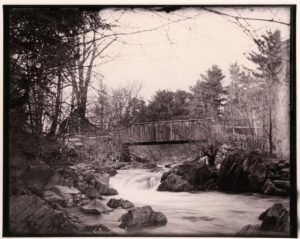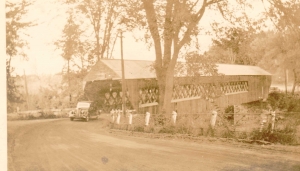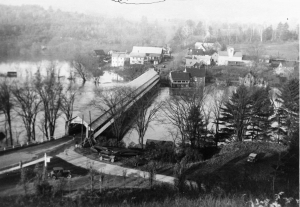Download Transcript Download Map Family Activities
If you enjoy the podcast, please consider joining NHS today as a member. Becoming a member will help us meet our operating costs during this Covid-19 crisis. Click here to join online
Listen on your iPhone with Apple Podcasts
If you are on your phone, go to the Apple Podcasts app and search for “Norwich Historical Driving Tours.”![]()
Narrated by David Macaulay and Sarah and Nelson Rooker
Tour Route
Begin and end the Driving Tour at Norwich Historical Society
277 Main Street
Continents collided, mountains tilted up. Mile-thick glaciers carved through the earth. Millions of years of water contoured this place. It’s the origin story of this place we call home.

Bridge over Blood Brook
Stop 1. The Mills at Blood Brook
Elm Street Bridge
The ledge outcroppings at Blood Brook, pressed upward over millions of years, created a natural spot for harnessing water into ponds to power mills.
Stop 2. Mechanic Street, or Hopson Road
8 Hopson Road
This area of Hopson Road was populated by day laborers and mechanics working at blacksmith and carpentry shops.
Stop 3. Pattersonville
12 Campbell Flats Road
This is the site of the former Pattersonville Chair Company factory village, complete with worker housing, a general store, dance hall, and mill.
Stop 4. Old Bridge Road Boat Ramp
Ompompanoosuc River Boat Ramp
This road used to be Route 5. The Route 5 bridge crossed here.
Stop 5. The View from Old Bridge Road
Intersection of Old Bridge Road and Route 5
Across Route 5, Kendall Station Road leads to what was once a busy railroad station for freight, the Pattersonville Chair Company, and the Strafford copper mine.
Stop 6. The River as a Transportation Artery
Intersection of Route 5 and Hemlock Road
Several vital transportation corridors, as well as a timeline of transportation history, can be seen from this location. The Connecticut River, the railroad, Vermont State Route 5, and Interstate 91 followed one after another through time.
Stop 7. Norwich Pumping Station
635 US Route 5
65,000 gallons of water a day, on average, are pumped from a well up to a holding tank on Dutton Hill. That water is then pumped back down to serve people in the Norwich village Fire District.
Stop 8. Lewiston
Ledyard Lane off River Road
The Lewiston area was home to Norwich’s first settlers, an important crossing to Hanover, and a transportation hub for Dartmouth
Credits
Produced by the Norwich Historical Society with support from the Norwich Historic Preservation Commission. The impetus for this podcast came from an architectural and archaeological survey conducted by Hartgen Archaeological Associates. Much of the information for this podcast was drawn from the writings of Brian Dade in Norwich, Vermont: A History, and in Proud to Live Here in the Connecticut River Valley of Vermont and New Hampshire, by Richard Ewald with Adair Mulligan. Thank you!
Jonathan Frishtick developed our map and Doug Lufkin designed the accompanying brochure. Dartmouth Printing Company provided printing of the brochure. Thanks to CATV for the use of their recording studio.
Special thanks to the National Park Service for its contribution through the Certified Local Government Program, administered by the Vermont Division for Historic Preservation.






